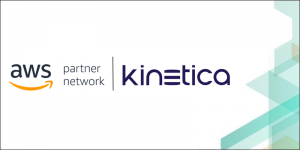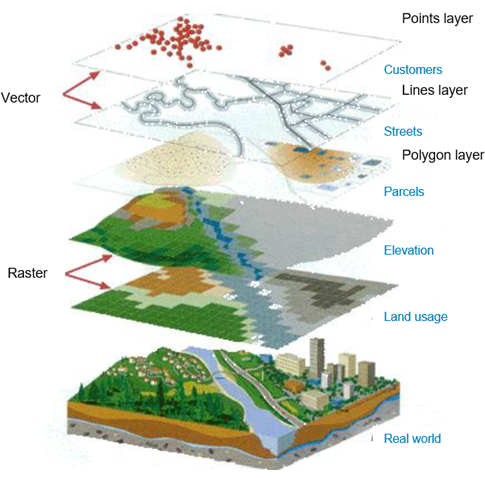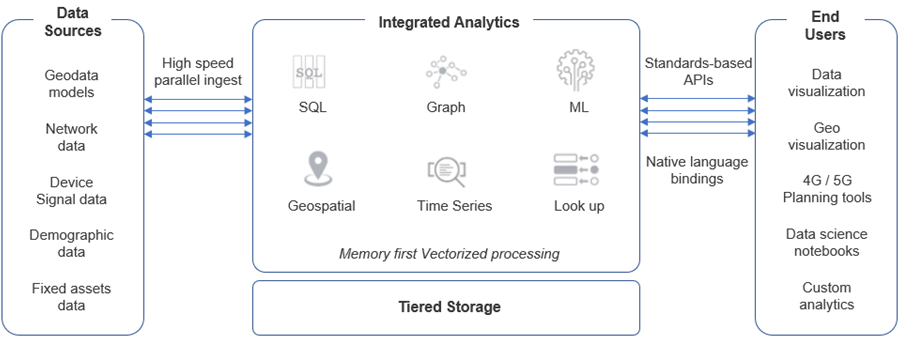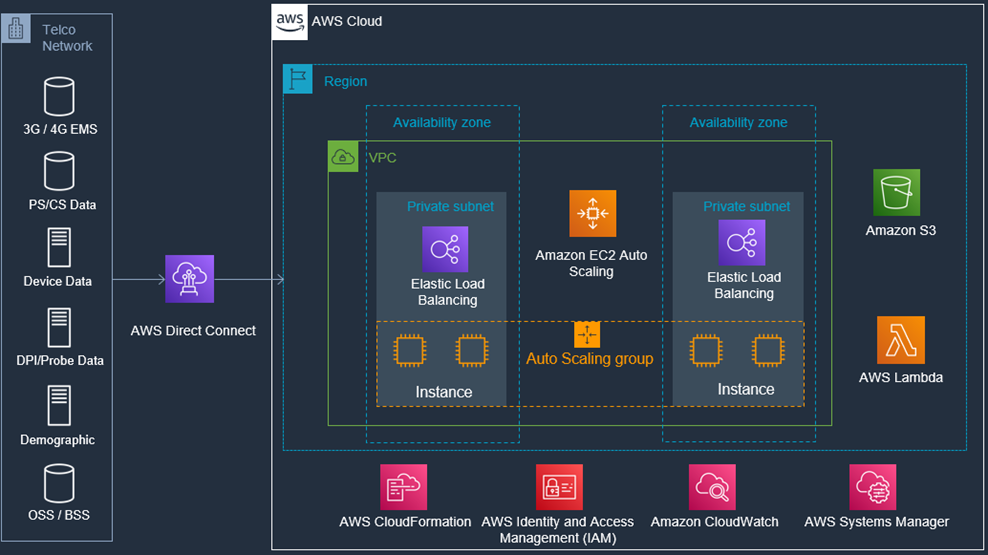AWS Partner Network (APN) Blog
How to Enhance 5G Network Planning Using Analytics for Faster Time to Market
By Hemant Rawat, Sr. Telco Solutions Architect – AWS
 |
| Kinetica |
 |
Everyone is excited to experience the promise of 5G: fast speeds, low latency, and the opportunity to connect everything. Communications service providers (CSPs) have a unique opportunity to power the digital economy by becoming an enabler for innovations across industries.
Building an optimized mobile network requires careful planning to ensure proper coverage and capacity. This post discusses how CSPs can augment their existing network planning with additional data while leveraging analytics for cell site placement and network optimizations.
Kinetica is an AWS Partner that provides an analytics platform on Amazon Web Services (AWS). A GPU-accelerated data platform, it unites historical analytics and streaming analytics, location intelligence, graph analytics, and machine learning to tackle massive scale network data challenges.
By leveraging the power of this platform, CSPs can accelerate their digital transformation, capitalize on the 5G opportunity, and gain a significant competitive advantage.
In this post, I will discuss the current challenges in network planning and how the Kinetica platform on AWS can be used to improve network planning and optimization processes by adding analytical capabilities to geospatial data and utilizing real-time visualization for accurate site predication.
Challenges
Building 5G networks involves various considerations, such as radio propagation, equipment characteristics, and use different cases. All of this makes network planning a challenging task.
5G New Radio (NR) will utilize various spectrum bands, making 5G network planning a complex and continuous activity.
Figure 1 – 5G spectrum bands.
CSPs are spending a significant amount of time and effort managing multiple network planning tools, which cannot handle large geospatial and diverse datasets, thus making predictive, dynamic analysis of critical initiatives like 5G rollout time-consuming and error prone.
Network planners need to be empowered with additional data and analytics tooling to make accurate site placement and network optimization decisions, thus safeguarding heavy capital investments.
Network Planning
In simpler terms, network planning helps decide the number of sites, their locations, and the best configuration to serve a specific geographical area and use case.
Traditional planning processes involve analyzing geographical conditions, overlaying radio propagation models, and applying equipment-specific characteristics to derive a deployment option that will provide satisfactory mobile services to the end user.
Let’s begin with the geospatial data. It contains details like digital terrain model (DTM), vector, clutter, population (urban, rural, airports), traffic maps, foliage, building, electromagnetic property of building materials, trees, water, vegetation, roads, bridges, and others.
Geodata resolution of such maps will now have to be one meter or less, as compared to five meters in LTE and 20 meters for 2G networks. This is because of the shorter distances covered by 5G mmWave. This makes the spatial analysis in 5G more complex, requiring more powerful processing capabilities.
Figure 2 – Digital terrain modeling.
Next, the radio propagation modeling calculates path loss, link budget, and cell range. Conventional practices of radio propagation modeling are not suited for 5G due to the diverse frequency bands.
The model needs to factor in losses from foliage, shadowing, Fresnel blockage, humidity, rain fade, and other factors. An additional consideration with technologies like mMIMO and Beamforming also need to be factored in.
LTE waves can travel larger distances and are able to penetrate walls, as they have low penetration loss, thus avoiding separate coverage planning for indoors. 5G mmWave, meanwhile, will barely be able to reach 300m and will not be able to cross walls, requiring more 5G antennas to be positioned throughout for the signals to be accessible.
5G also needs many small cells to handle in-building deployments. Coverage prediction errors can result in over- or under-provisioning of cell sites, impacting the user experience and capital expenditures (CapEx).
Lastly, vendor-specific RF components pose another challenge in 5G network planning. Parameters like gNB transmitter power, receiver sensitivity, antenna parameters, and cable length need to be overlaid to provide an accurate model. Integrated or large array antennas will need a more precise location to achieve minimum SINR and reduce interference.
In summary, 5G network planning requires large and diverse datasets to safeguard investments and ensure a good customer experience. Big data tools are not predominately leveraged currently for network planning, as their implementation is not geared to handle the massive geospatial analytical workloads.
Similarly, business data like high revenue spots, public spaces, business district details, ARPU, and customer profiling are analyzed in silos.
For accurate 5G network planning, nothing can be left for guesswork; 10% of inaccuracy could have been accommodated in LTE planning, but an -3dB of miscalculation in 5G can result in 40% more sites than needed. CSPs need to process different statistical modeling and large and diverse data sets, in seconds compared to hours.
Kinetica’s Solution
With Kinetica on AWS, CSPs can significantly accelerate 5G planning with interactive and predictive modeling of network coverage at scale.
The platform supports analyzing multitudes of data from different sources. AWS provides a scalable platform to accommodate growing volumes of data and provides a GPU-powered computing capability for faster interactive analysis.
Figure 3 – Solution building blocks.
Powered by cutting-edge vectorized architecture, Kinetica on AWS provides a real-time analytic database to solve a CSP’s complex network problems, with best-in-class location intelligence.
Kinetica on AWS allows CSPs to quickly develop and deploy complex RF propagation models against business and location datasets for visual and interactive scenario analysis. CSPs are then able to de-risk the decision-making of deploying in a market and run more iterations of detailed, interactive scenarios, maximizing the ROI of small cell deployments.
Kinetica on AWS has a distributed architecture that has been designed for telco data processing at scale. A standard cluster consists of identical Amazon Elastic Compute Cloud (Amazon EC2) instances powered with GPUs, from accelerated computing instance family, inside an Amazon Virtual Private Cloud (VPC) as shown in Figure 4.
The solution is designed to be highly scalable and has a high availability deployment. A cluster can be scaled at any time to increase storage capacity and processing power, with near-linear scale processing improvements for most operations.
Figure 4 – Kinetica on AWS for network planning.
AWS CloudFormation is used to fully manage the creation, deletion, management, and configuration of the deployment. AWS Direct Connect enables a dedicated private network connection from CSPs data center to AWS Region.
Hierarchical memory and storage management is recommended for capacity and performance. Each storage tier is defined by an overall capacity and expected level of performance that’s generally inversely proportional to that capacity.
For example, the GPU-Video RAM (VRAM) tier usually has the smallest total memory but is the most performant for processing data, and the Amazon Simple Storage Service (Amazon S3) storage tier would be the largest tier where data is retained for historical analysis.
CSPs leverage Kinetica on AWS to dynamically visualize and analyze their RF propagation models for a given market against a building footprint dataset of millions of buildings. It can determine the rate and area of coverage for each building and perform a total linear footage calculation for the exterior of each building. This is used to determine whether a building is considered to be covered, based on carrier standards.
CSPs can quickly understand and analyze different scenarios for 5G coverage, while planners can interact with the data in real-time. Kinetica on AWS can also perform interactive line-of-sight analysis to better understand the impact of fixed assets on coverage.
Figure 5 – Coverage analysis.
CSPs can apply machine learning algorithms on data stored in the platform. This is critical for predictive analysis around the best placement for 5G cells, network towers, and other aspects like network utilization.
Customer Use Case
This solution is used by leading telcos today to take a data-driven approach towards 5G network planning. One of the Tier-1 U.S. telcos leverages Kinetica on AWS to rapidly model hundreds of potential 5G deployment scenarios for any given market.
This helped them determine which configuration of small cells would provide the greatest coverage to existing customers, high priority customers, and most likely candidate customers to churn from another provider.
With Kinetica on AWS, the telco is able to run scenarios in seconds rather than hours, providing the flexibility to adjust model variables with exponentially more scenarios to minimize risk in deployment decisions.
Conclusion
We are seeing a consistent pattern with communications service providers (CSPs) pushing for 5G, making it essential to evolve network planning beyond looking at coverage maps. Data will continue to grow, and fast-moving streaming data will increasingly be used to support critical 5G decision making.
With analytics, CSPs can accelerate 5G planning and rollouts with interactive, predictive modeling of network coverage at scale. The Kinetica on AWS platform can also help optimize existing 4G networks and enable value added, data-powered telco applications.
Key benefits that telcos can derive from Kinetica on AWS are:
- Geospatial analysis at speed and scale.
- Speed of visualization.
- Ability to blend business and location data.
Without this, telcos risk making sub-optimal investments or missing opportunities to provide new revenue-generating services.
Kinetica – AWS Partner Spotlight
Kinetica is an AWS Partner that provides an analytics platform on AWS. A GPU-accelerated data platform, it unites historical analytics and streaming analytics, location intelligence, graph analytics, and machine learning to tackle massive scale network data challenges.
Contact Kinetica | Partner Overview
*Already worked with Kinetica? Rate the Partner
*To review an AWS Partner, you must be a customer that has worked with them directly on a project.





